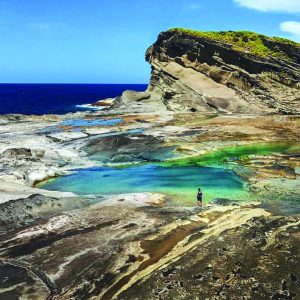Move could elevate it a protected tourism site

TACLOBAN CITY – The renowned rock formations in Biri Island, Northern Samar, have been submitted by the provincial government for consideration as a global geopark under the United Nations Educational, Scientific, and Cultural Organization(Unesco).
On May 23, Ivan Anthony Henares, the secretary-general of the Unesco National Commission of the Philippines, led a group of experts in visiting the Biri rock formations in Barangay Progress for their initial assessment.
Unesco defines a global geopark as a single, unified geographical area where sites and landscapes of international geological significance are managed with a holistic concept of protection, education, and sustainable development.
Local officials are confident that the Biri rock formations, composed of limestone, could qualify as a global geopark.
“We believe that Biri’s majestic rock formations are places of outstanding geological heritage. This designation will support sustainable development through conservation, education, community engagement, and sustainable tourism,” Carl Sanchez Bordeos, the culture and arts coordinator of the Provincial Tourism Office of Northern Samar, said in an interview.
The rock formations in Biri, located about 38 kilometers from the provincial capital of Catarman, were formed around 18 million years ago through natural processes such as tectonic movements, wave actions, and weathering.
Bordeos noted that the intricate patterns and imposing structures of these rocks have fascinated both geologists and tourists.
The formations exhibit a variety of sedimentary and volcanic features, making them valuable for scientific study and captivating for eco-tourism.
There are seven rock formations in Brgy. Progress, which occupies 246,932.867 square meters, named by locals as Magasang, Magsapad, Macadlaw, Puhunan, Caranas, Pinanahawan, and Bel-at, where a natural pool can be found.
“The declaration of the Biri rock formations as a global geopark would help preserve its cultural, historical, and natural heritage,” Bordeos said.
“These rock formations were formed millions of years ago, highlighting their superior geological, natural, and cultural heritage. We aim to protect this natural heritage and share it with the world,” he added.
Biri Island, facing the Pacific Ocean and San Bernardino Strait, played a significant role during the Manila Galleon trade, adding to its cultural and historical significance.
The provincial and municipal governments of Biri requested Unesco to assess the Biri rock formations in December of last year. Geologists from Unesco are expected to visit the formations for further assessment and study.
Vicky Mabutin, the tourism officer of Biri, expressed excitement about the prospect of Unesco recognition.
“The rock formations are our town’s tourism gem. Last year alone, over 5,000 tourists visited the place,” she said.
If approved, the Biri rock formations would become the second Unesco global geopark in the Philippines, the first being the island of Bohol declared last year.
JOEY A. GABIETA



